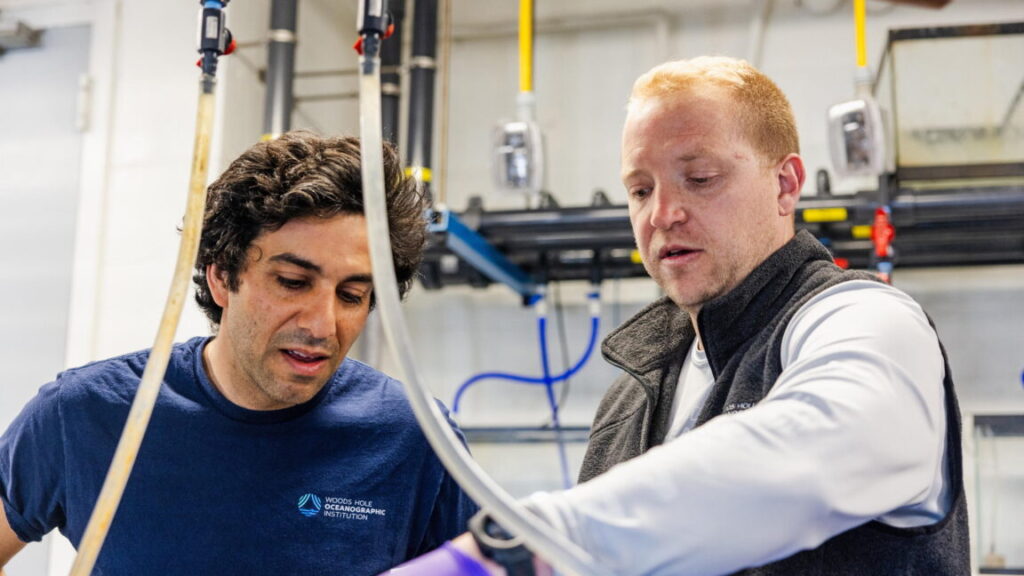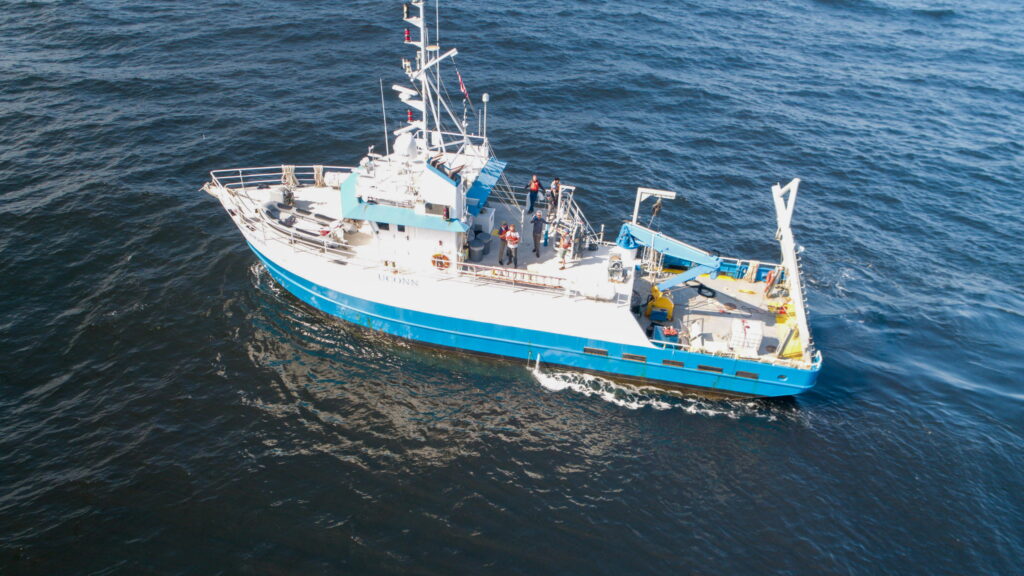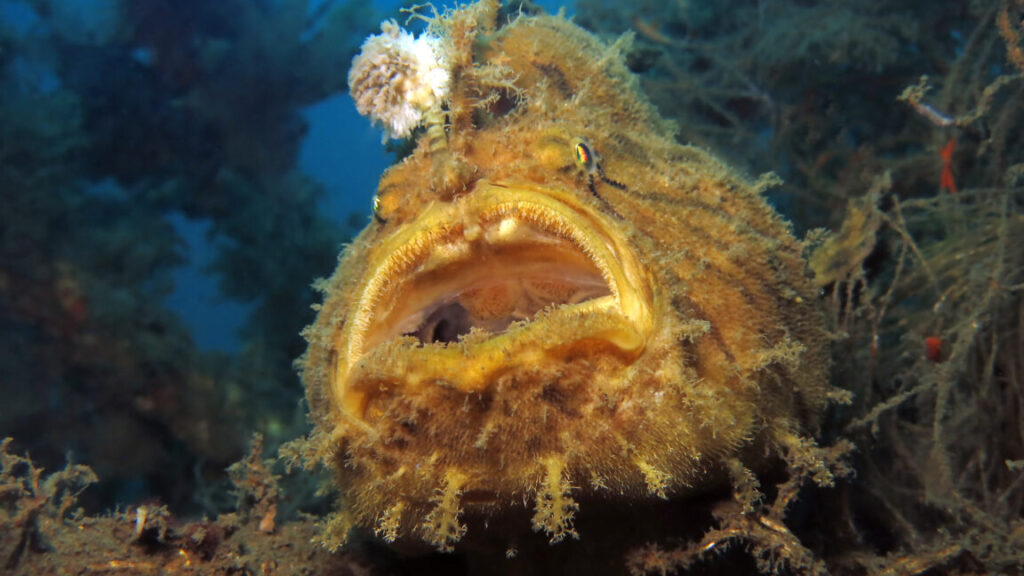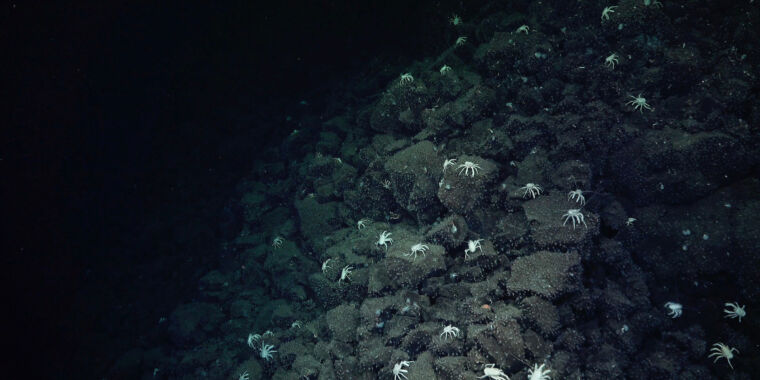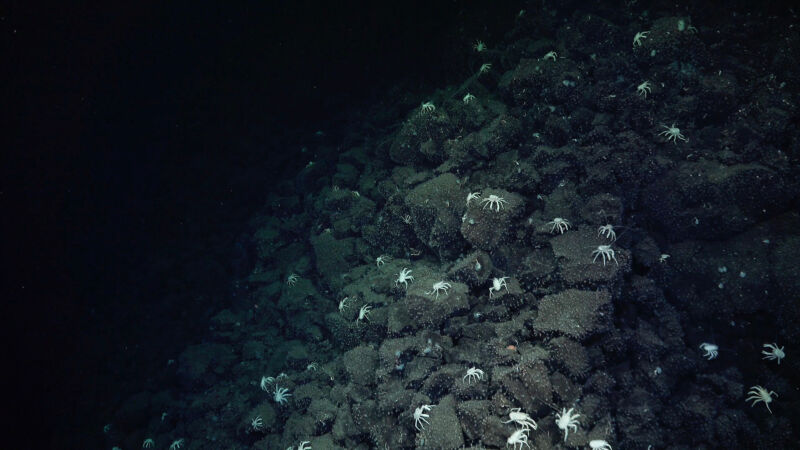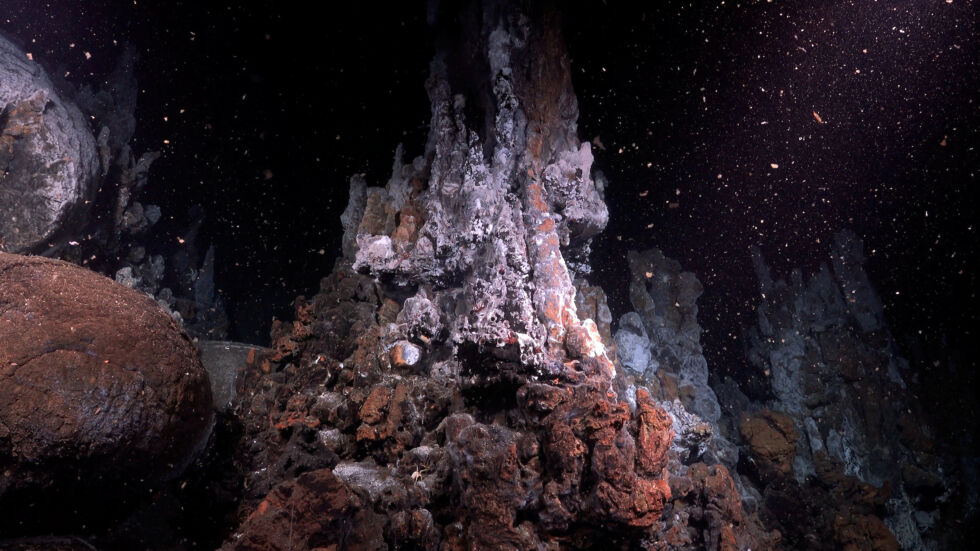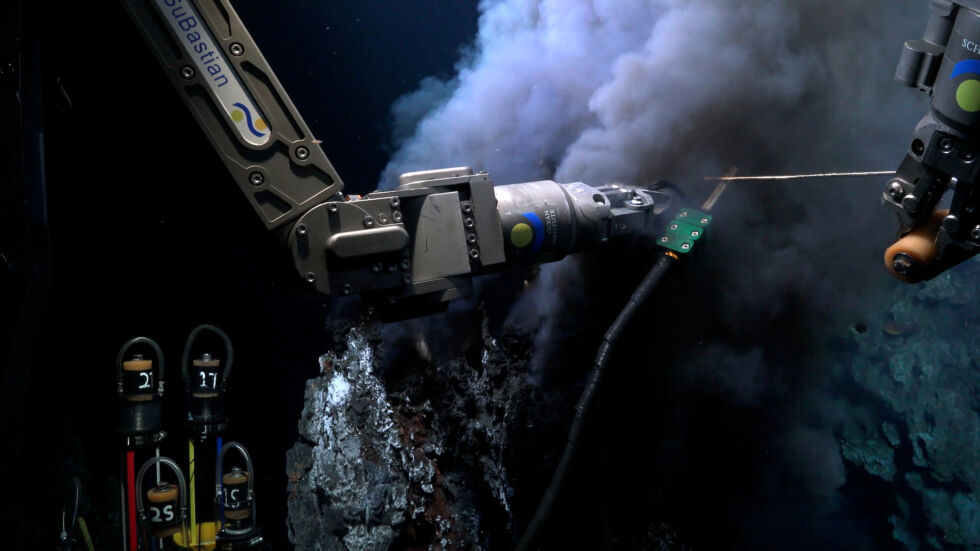Experiment will attempt to counter climate change by altering ocean
Gulf of Maine will be site of safety and effectiveness testing.
Woods Hole researchers, Adam Subhas (left) and Chris Murray, conducted a series of lab experiments earlier this year to test the impact of an alkaline substance, known as sodium hydroxide, on copepods in the Gulf of Maine. Credit: Daniel Hentz/Woods Hole Oceanographic Institution
Later this summer, a fluorescent reddish-pink spiral will bloom across the Wilkinson Basin in the Gulf of Maine, about 40 miles northeast of Cape Cod. Scientists from the Woods Hole Oceanographic Institution will release the nontoxic water tracer dye behind their research vessel, where it will unfurl into a half-mile wide temporary plume, bright enough to catch the attention of passing boats and even satellites.
As it spreads, the researchers will track its movement to monitor a tightly controlled, federally approved experiment testing whether the ocean can be engineered to absorb more carbon, and in turn, help combat the climate crisis.
As the world struggles to stay below the 1.5° Celsius global warming threshold—a goal set out in the Paris Agreement to avoid the most severe impacts of climate change—experts agree that reducing greenhouse gas emissions won’t be enough to avoid overshooting this target. The latest Intergovernmental Panel on Climate Change report, published in 2023, emphasizes the urgent need to actively remove carbon from the atmosphere, too.
“If we really want to have a shot at mitigating the worst effects of climate change, carbon removal needs to start scaling to the point where it can supplement large-scale emissions reductions,” said Adam Subhas, an associate scientist in marine chemistry and geochemistry at the Woods Hole Oceanographic Institution, who will oversee the week-long experiment.
The test is part of the LOC-NESS project—short for Locking away Ocean Carbon in the Northeast Shelf and Slope—which Subhas has been leading since 2023. The ongoing research initiative is evaluating the effectiveness and environmental impact of a marine carbon dioxide removal approach called ocean alkalinity enhancement (OAE).
This method of marine carbon dioxide removal involves adding alkaline substances to the ocean to boost its natural ability to neutralize acids produced by greenhouse gases. It’s promising, Subhas said, because it has the potential to lock away carbon permanently.
“Ocean alkalinity enhancement does have the potential to reach sort of gigatons per year of carbon removal, which is the scale at which you would need to supplement emissions reductions,” Subhas said. “Once the alkalinity is dissolved in seawater, it reacts with carbon dioxide and forms bicarbonate—essentially dissolved baking soda. That bicarbonate is one of the most stable forms of carbon in the ocean, and it can stay locked away for tens of thousands, even hundreds of thousands of years.”
But it will be a long time before this could happen at the magnitude needed to mitigate climate change.
According to Wil Burns, co-director of the Institute for Responsible Carbon Removal at American University, between 6 and 10 gigatons of carbon need to be removed from the atmosphere annually by 2050 in order to meet the Paris Agreement climate target. “It’s a titanic task,” he said.
Most marine carbon dioxide removal initiatives, including those involving OAE, are still in a nascent stage.
“We’re really far from having any of these technologies be mature,” said Lisa Levin, an oceanographer and professor at the Scripps Institution of Oceanography at the University of California San Diego, who spoke on a panel at the United Nations Ocean Conference in June about the potential environmental risks of mining and carbon dioxide removal on deep-sea ecosystems. “We’re looking at a decade until any serious, large-scale marine carbon removal is going to be able to happen—or more.”
“In the meantime, everybody acknowledges that what we have to do is to reduce emissions, right, and not rely on taking carbon out of the atmosphere,” she said.
Marine carbon dioxide removal
So far, most carbon removal efforts have centered on land-based strategies, such as planting trees, restoring soils, and building machines that capture carbon dioxide directly from the air. Increasingly, researchers are exploring whether the oceans might help.
“Looking at the oceans makes a lot of sense when it comes to carbon removal, because the oceans sequester 70 times more CO2 than terrestrial sources,” Burns said. What if it can hold more?
That question is drawing growing attention, not only from scientists. In recent years, a wave of private companies have started piloting various methods of removing carbon from the oceans.
“It’s really the private sector that’s pushing the scaling of this very quickly,” Subhas said. In the US and Canada, he said, there are at least four companies piloting varied ocean alkalinity enhancement techniques.
Last year, Ebb Carbon, a California-based startup focused on marine carbon dioxide removal, signed a deal with Microsoft to remove up to 350,000 metric tons of CO2 over the next decade using an ocean alkalinity enhancement process that splits seawater into acidic and alkaline streams. The alkaline stream is then returned to the sea where it reacts with CO2 and stores it as bicarbonate, enabling the ocean to absorb more carbon dioxide from the atmosphere. In return, Microsoft will purchase carbon removal credits from the startup.
Another company called Vesta, which has headquarters in San Francisco, is using an approach called Coastal Carbon Capture. This involves adding finely ground olivine—a naturally occurring olive-green colored mineral—to sandy beaches. From there, ocean tides and waves carry it into the sea. Olivine reacts quickly with seawater in a process known as enhanced weathering, increasing ocean alkalinity. The company piloted one of their projects in Duck, North Carolina, last year where it estimated approximately 5,000 metric tons of carbon dioxide would be removed through coastal carbon capture after accounting for project emissions, according to its website.
But these efforts are not without risk, AU’s Burns said. “We have to proceed in an extremely precautionary manner,” he said.
Some scientists are concerned that OAE initiatives that involve olivine, which contains heavy metals like nickel and chromium, may harm marine life, he said. Another concern is that the olivine could cloud certain ocean areas and block light from penetrating to deeper depths. If too much alkalinity is introduced too fast in concentrated areas, he said, some animals might not be able to adjust.
Other marine carbon dioxide removal projects are using other methods besides OAE. Some involve adding iron to the ocean to stimulate growth in microscopic plants called phytoplankton, which absorb carbon dioxide through photosynthesis. Others include the cultivation of large-scale farms of kelp and seaweed, which also absorb carbon dioxide through photosynthesis. The marine plants can then be sunk in the deep ocean to store the carbon they absorbed.
In 2023, researchers from Woods Hole Oceanographic Institution conducted their first OAE-related field experiment from the 90-foot research vessel R/V Connecticut south of Massachusetts. As part of this first experiment, nontoxic water tracer dye was released into the ocean. Researchers tracked its movement through the water for 72 hours to model the dispersion of a plume of alkalinity over time.
Credit: Woods Hole Oceanographic Institution
In 2023, researchers from Woods Hole Oceanographic Institution conducted their first OAE-related field experiment from the 90-foot research vessel R/V Connecticut south of Massachusetts. As part of this first experiment, nontoxic water tracer dye was released into the ocean. Researchers tracked its movement through the water for 72 hours to model the dispersion of a plume of alkalinity over time. Credit: Woods Hole Oceanographic Institution
One technique that has not yet been tried, but may be piloted in the future, according to the science-based conservation nonprofit Ocean Visions, would employ new technology to accelerate the ocean’s natural process of transferring surface water and carbon to the deep ocean. That’s called artificial downwelling. In a reverse process—artificial upwelling—cooler, nutrient-rich waters from the deep ocean would be pumped to the surface to spur phytoplankton growth.
So far, UC San Diego’s Levin said she is not convinced that these trials will lead to impactful carbon removal.
“I do not think the ocean is ever going to be a really large part of that solution,” she said. However, she added, “It might be part of the storage solution. Right now, people are looking at injecting carbon dioxide that’s removed from industry activities on land and transporting it to the ocean and injecting it into basalt.”
Levin said she’s also worried that we don’t know enough yet about the consequences of altering natural ocean processes.
“I am concerned about how many field trials would be required to actually understand what would happen, and whether we could truly understand the environmental risk of a fully scaled-up operation,” she said.
The experiment
Most marine carbon dioxide removal projects that have kicked off already are significantly larger in scale than the LOC-NESS experiment, which Subhas estimates will remove around 50 tons of CO2.
But, he emphasized, the goal of this project is not to compete in size or scale. He said the aim is to provide independent academic research that can help guide and inform the future of this industry and ensure it does not have negative repercussions on the marine environment.
There is some concern, he said, that commercial entities may pursue large-scale OAE initiatives to capitalize on the growing voluntary carbon market without first conducting adequate testing for safety and efficacy. Unlike those initiatives, there is no profit to be made from LOC-NESS. No carbon credits will be sold, Subhas said.
The project is funded by a collection of government and philanthropic sources, including the National Oceanic and Atmospheric Administration and the Carbon to Sea Initiative, a nonprofit that brings funders and scientists together to support marine carbon dioxide removal research and technology.
“We really feel like it’s necessary for the scientific community to be delivering transparent, trusted, and rigorous science to evaluate these things as these activities are currently happening and scaling in the ocean by the private sector,” Subhas said.
The LOC-NESS field trial in Wilkinson Basin will be the first “academic only” OAE experiment conducted from a ship in US waters. It is also the first of its kind to receive a permit from the Environmental Protection Agency under the Marine Protection, Research, and Sanctuaries Act.
“There’s no research in the past or planned that gets even close to providing a learning opportunity that this research is providing for OAE in the pelagic environment,” said Carbon to Sea Initiative’s Antonius Gagern, referring to the open sea experiment.
The permit was granted in April after a year of consultations between the EPA and other federal agencies.
During the process’ public comment periods, commenters expressed concerns about the potential impact on marine life, including the critically endangered North Atlantic right whales, small crustaceans that they eat called copepods, and larvae for the commercially important squid and mackerel fisheries. In a written response to some of these comments, the EPA stated that the small-scale project “demonstrates scientific rigor” and is “not expected to significantly affect human health, the marine environment, or other uses of the ocean.”
Subhas and his interdisciplinary team of chemists, biologists, engineers, and physicists from Woods Hole have spent the last few years planning this experiment and conducting a series of trials at their lab on Cape Cod to ensure they can safely execute and effectively monitor the results of the open-water test they will conduct this summer in the Gulf of Maine.
They specifically tested the effects of sodium hydroxide—an alkaline substance also known as lye or caustic soda—on marine microbes, phytoplankton, and copepods, a crucial food source for many marine species in the region in addition to the right whales. “We chose sodium hydroxide because it’s incredibly pure,” Subhas said. It’s widely used in the US to reduce acidity in drinking water.
It also helps counter ocean acidification, according to Subhas. “It’s like Tums for the ocean,” he said.
Ocean acidification occurs when the ocean absorbs excess carbon dioxide, causing its pH to drop. This makes it harder for corals, krill, and shellfish like oysters and clams to develop their hard calcium carbonate shells or skeletons.
This month, the team plans to release 50 tons of sodium hydroxide into a designated area of the Wilkinson Basin from the back of one of two research vessels participating in the LOC-NESS operation.
The basin is an ideal test site, according to Subhas, because there is little presence of phytoplankton, zooplankton, commercial fish larvae, and endangered species, including some whales, during this season. Still, as a precautionary measure, Woods Hole has contracted a protected species observer to keep a look out for marine species and mitigate potential harm if they are spotted. That person will be on board as the vessel travels to and from the field trial site, including while the team releases the sodium hydroxide into the ocean.
The alkaline substance will be dispersed over four to 12 hours off the back of one of the research vessels, along with the nontoxic fluorescent red water tracer dye called rhodamine. The dye will help track the location and spread of the sodium hydroxide once released into the ocean, and the vessel’s wake will help mix the solution in with the ocean water.
After about an hour, Subhas said, it will form into a “pinkish” patch of water that can be picked up on satellites. “We’re going to be taking pictures from space and looking at how this patch sort of evolves, dilutes, and stretches and disperses over time.”
For a week after that, scientists aboard the vessels will take rotating shifts to collect data around the clock. They will deploy drones and analyze over 20 types of samples from the research vessel to monitor how the surrounding waters and marine life respond to the experiment. They’ll track changes in ocean chemistry, nutrient levels, plankton populations and water clarity, while also measuring acidity and dissolved CO2.
In March, the team did a large-scale dry run of the dispersal at an open air testing facility on a naval base in New Jersey. According to Subhas, the trial demonstrated their ability to safely and effectively deliver alkalinity to surface seawater.
“The next step is being able to measure the carbon uptake from seawater—from the atmosphere into seawater,” he said. That is a slower process. He said he expects to have some preliminary results on carbon uptake, as well as environmental impacts, early next year.
This story originally appeared on Inside Climate News.
Experiment will attempt to counter climate change by altering ocean Read More »
